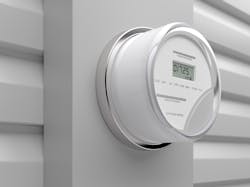Smart Meters Make a Comeback, While Energy Storage and Microgrids Surge
According to the Advanced Energy Now 2019 Market Report, within the electricity delivery and management segment of advanced energy, it is noteworthy that advanced metering infrastructure (AMI) had two big revenue years in the United States recently, jumping 65% in 2017, to US$1.4 billion, and holding roughly steady in 2018. Smart meters and related infrastructure are foundational for much innovation in the electric power sector, including reforms like time-of-use rates. But revenue from deployments of this equipment had tapered off from the 2011 to 2012 level of nearly US$1.7 billion a year, when utility investments were driven by the federal American Recovery and Reinvestment Act. Spending on AMI reached a low of US$860 million in 2016, but in the past two years, AMI deployment has had a bit of a revival.
Even more noteworthy is the fastest growth in this segment — which totaled US$135 billion worldwide and US$21.3 billion in the United States in 2018 — over the past five years has been in energy storage. This market started at a low base, but revenue has multiplied eight-fold over the seven-year period, recording double-digit gains in 2017 and 2018 in both U.S. and world markets.
Worldwide revenue for energy storage has grown from US$462 million in 2014 to US$2.4 billion in 2018. In the United States, energy storage revenue has climbed from US$58 million to US$701 million over the past five years.
Over the past year, renewables-plus-storage projects were largely the driving force behind new announcements. One of the more interesting projects announced in 2018 was a lithium ion (Li-ion) battery being developed at India’s first-ever wind and solar hybrid project. Hero Future Energies, the owner/operator of the project, stated that the hybrid plant has seen extremely good wind production and consequently must curtail solar because of capacity constraints on the local grid. The Li-ion battery will help mitigate the need for curtailment. If all goes as planned on this pilot project, then the company will retrofit older renewable projects as well as include a storage component in all new projects.
Traditional generation replacement is also a key driver for utility-scale storage. One of the most notable tenders last year was Pacific Gas and Electric’s (PG&E) solicitation for energy storage to replace three power plants in its service territory. The gas-fired plants it is replacing had operated as reliability-must-run resources. Deploying strategically located energy storage will help lower operating costs and address congestion issues in the region.
Distributed energy storage systems continue to grow slowly throughout global markets, accounting for 23% of new capacity announced in 2018 (excluding pumped hydro). These systems are frequently paired with other generating assets (renewable or otherwise) and are chiefly used for applications like demand charge management, peak shifting, and resilience/backup power.
In the U.S. market for electricity delivery and management technologies, microgrids are another shining light.
In 2018, U.S. revenue from microgrids was just under US$2.5 billion, accounting for 35% of the global market. This is due, in part, to U.S. electricity networks being, in general, less reliable than in Europe. According to the Council of European Energy Regulators, the United States lost an average of 244 minutes per customer in 2012, compared with 95 minutes per customer in France, 81 minutes per customer in the United Kingdom, and 16 minutes per customer in Germany. Large customers such as hospitals, university campuses, and military bases are increasingly deploying microgrid technologies so that they can island themselves from the grid and become energy self-sufficient in the event of a power outage.
Emerging markets are also an area of growth for microgrids, as power grids in these markets are among the least reliable. While 2017 saw a significant increase in the adoption of microgrid technology, the market was not sustained in 2018, as deployment slipped back closer to 2016 levels.
One indication of the growth trajectory comes from the Microgrid Deployment Tracker, in which more than 200 new microgrids operating and under development in Q2 2018 were identified around the world. The United States remains the market leader in terms of projects currently operating and connected to a distribution grid. In addition, the remote microgrid segment has also declined as an overall portion of the total market, but some of this is because of better availability of data for grid-tied systems. It also reflects growing interest in alternative aggregation models (such as grid-dependent virtual power plants) in regions traditionally dominated by remote microgrids (such as Australia).
The microgrid market has made leaps and bounds over the past two years, particularly on controls platforms, greater interest in modular, plug-and-play offerings, and creative business models. The increase in extreme weather events, threat of wildfires, and localized phenomena such as earthquakes and volcanic eruptions all build the business case for greater energy resilience. Microgrids can serve as platforms for other services as well, including thermal energy, water, and basic telecommunications infrastructure. As a result, Navigant Research expects total microgrid capacity to grow from 3.2 GW in 2019 to 15.8 GW by 2027.
About the Author
Robert Keough
Robert Keough is senior vice president, Content, at Advanced Energy Economy (AEE). Keough previously served as assistant secretary for Communications and Public Affairs in the Massachusetts Executive Office of Energy and Environmental Affairs. AEE is a national association of business leaders whose mission is to make the global energy system more secure, clean, and affordable; transforming public policy to enable the growth of advanced energy companies.
